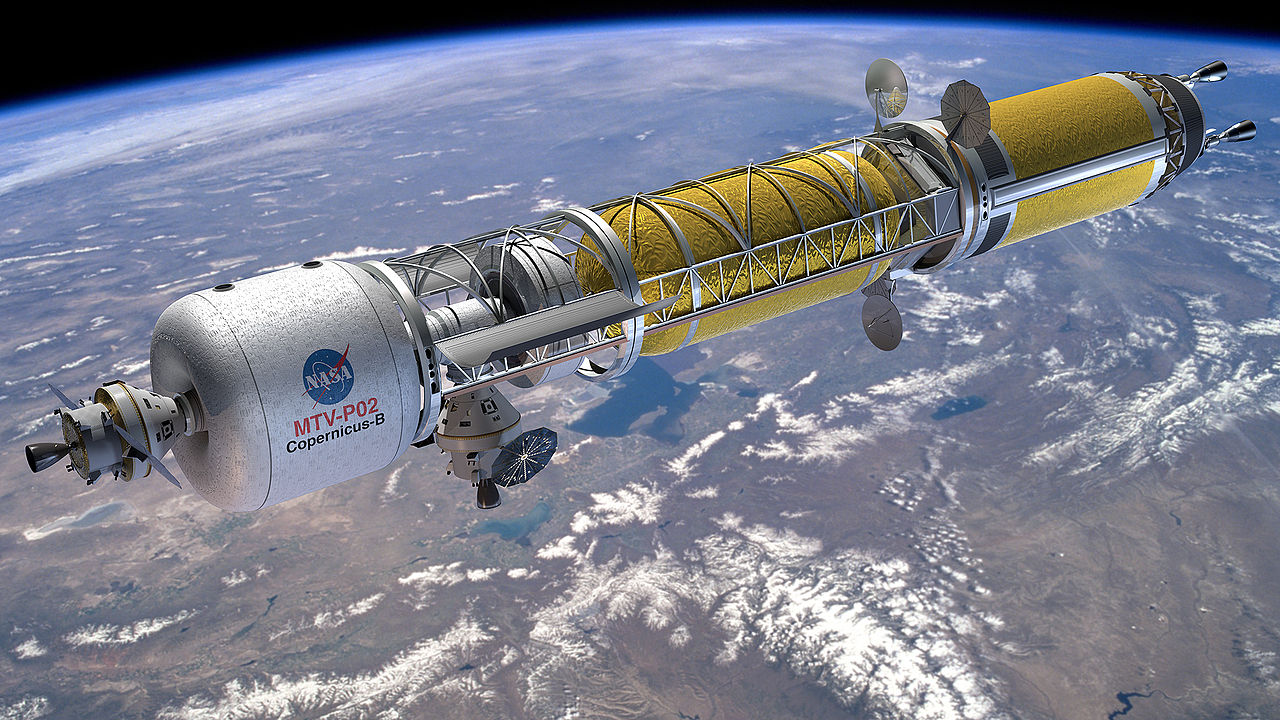Imagine you’re an astronaut strapped into a spacecraft hurtling toward Mars. The journey isn’t the grueling nine-month slog of old chemical rockets—it’s a brisk two months, thanks to a nuclear engine humming quietly in the background. As a lifelong space enthusiast who’s followed missions from Apollo to Artemis, I’ve always been fascinated by how nuclear tech turns these dreams into reality. It’s not just about power; it’s about unlocking the cosmos in ways that feel almost magical, yet grounded in hard science.
What is Nuclear Technology in Space?
Nuclear technology in space harnesses atomic reactions to generate energy or propulsion, far outpacing solar or chemical alternatives in efficiency and longevity. From powering distant probes to thrusting crews across interplanetary voids, it’s the backbone of deep-space ambitions. Think of it as the ultimate endurance athlete: reliable, potent, and ready for the long haul.
Radioisotope Thermoelectric Generators (RTGs)
RTGs convert heat from radioactive decay into electricity, providing steady power without moving parts or sunlight dependency. They’ve been mission-savers for decades, keeping instruments alive in the cold, dark reaches beyond Jupiter. No wonder NASA’s rovers swear by them—literally a hot commodity in freezing space.
Nuclear Propulsion Systems
These systems use fission to heat propellants or generate electricity for ion drives, slashing travel times and fuel needs. Unlike traditional rockets that guzzle chemicals, nuclear ones sip resources while delivering massive thrust. It’s like upgrading from a bicycle to a jet engine for your cosmic commute.
The History of Nuclear Power in Space
The story starts in the 1960s with projects like NERVA, where NASA tested nuclear thermal engines to cut Mars trips in half. Though Cold War politics shelved them, RTGs debuted on Transit 4A in 1961, powering navigation satellites reliably. Fast-forward to Voyager probes in 1977—they’re still chatting home after 48 years, all thanks to plutonium hearts.
I recall poring over Voyager images as a teen, marveling at Jupiter’s storms. Those snapshots? Courtesy of nuclear tech that outlasted expectations. It’s a tale of human ingenuity, blending atomic might with exploratory spirit, proving nukes aren’t just bombs—they’re beacons.
Current Applications in Space Missions
Today, nuclear tech fuels everything from Mars rovers to outer-planet orbiters, enabling science where solar panels falter. Perseverance rover’s RTG, for instance, powers its drills and helicopter buddy Ingenuity on the Red Planet. Without it, we’d be blind to Martian secrets.
Rovers and Landers
Curiosity and Perseverance use Multi-Mission RTGs to generate about 110 watts, enough for years of trekking and sampling. These nuclear batteries endure radiation and dust storms that would kill solar setups. It’s like giving your robot explorer an infinite energy drink.
Deep-Space Probes
Voyager, New Horizons, and Cassini all relied on RTGs to beam data from Pluto and Saturn. Cassini’s 13-year Saturn stint revealed icy moons with potential life—nuclear power made that epic possible. Humorously, it’s the tech that keeps probes “alive” longer than most marriages.
Nuclear Propulsion: The Game-Changer
Nuclear propulsion promises to revolutionize travel, with systems like NTP heating hydrogen for high-thrust bursts. NASA’s DRACO program, partnering with DARPA, aims for 2027 demos, potentially halving Mars transit times. It’s not sci-fi; it’s engineering edging us closer to stars.
Nuclear Thermal Propulsion (NTP)
NTP uses a reactor to superheat propellant, expelling it for thrust twice as efficient as chemicals. Recent 2025 tests at Marshall Space Flight Center validated fuels for agile cislunar ops. Imagine zipping to the Moon in days—NTP makes that feasible.
Nuclear Electric Propulsion (NEP)
NEP generates electricity from fission to ionize gases, offering low-thrust but ultra-efficient pushes for cargo hauls. NASA’s MARVL project in 2025 explores modular radiators assemblable in space, dodging rocket size limits. It’s the tortoise that wins deep-space races.
Advantages of Nuclear Tech in Space
Nuclear systems boast high energy density, enabling longer missions with less mass—crucial for crewed flights. They operate in sunless voids, unlike solar, and provide constant power for habitats or instruments. Plus, they reduce radiation exposure by shortening trips.
- High Efficiency: Double the specific impulse of chemical rockets, meaning more bang per fuel buck.
- Longevity: RTGs last decades; fission reactors could power lunar bases indefinitely.
- Versatility: From propulsion to surface power, nukes adapt to diverse needs.
But challenges loom: safety concerns during launches, high development costs, and political hurdles over uranium use. Pros outweigh cons for ambitious explorers, though.
Pros and Cons of Nuclear Propulsion
Pros include faster transits (Mars in 3-4 months vs. 7-9), lower fuel mass, and dual-use for power generation. Cons? Radiation risks, complex engineering, and public fears of accidents—remember, no nukes have failed in space yet.
Challenges and Safety Concerns
Safety is paramount; reactors stay cold until orbit to avoid fallout. IAEA panels stress rigorous testing, as in 2022 discussions on minimizing risks for manned missions. Emotionally, it’s scary—like handling fire—but protocols make it safer than driving.
One real example: The 1964 SNAP-9A RTG accident scattered plutonium, but modern designs are tougher. Humor helps: Nuclear space tech is like coffee—hot, energizing, but spill-proof containers are key.
Comparing Nuclear vs. Chemical Propulsion
| Aspect | Nuclear Propulsion | Chemical Propulsion |
|---|---|---|
| Efficiency (ISP) | 800-1000 seconds | 300-450 seconds |
| Travel Time to Mars | 3-6 months | 7-9 months |
| Fuel Mass | Lower (high energy density) | Higher (needs massive tanks) |
| Power Source | Fission (constant) | Combustion (short bursts) |
| Best For | Deep space, long-duration | Launches, quick maneuvers |
Nuclear wins for endurance, but chemicals excel in raw thrust for liftoffs. Hybrids might blend both worlds soon.
Recent Developments in 2025
2025 saw breakthroughs like NASA’s NEP tech maturation plan, focusing on in-space assembly for football-field-sized radiators. DARPA’s DRACO extended contracts for reactor designs, eyeing Mars crew safety. Russia’s plasma-nuke hybrid prototypes hint at 30-day Mars jaunts—exciting times!
A personal anecdote: Chatting with a NASA engineer friend last year, he geeked out over NTP fuel tests. “It’s like reigniting the Apollo fire,” he said. With China’s advances, the race is on—nuclear could decide who plants the next flag.
Future Prospects and Innovations
Looking ahead, fission surface power for Moon bases could support Artemis habitats by 2030. Companies like NANO Nuclear eye microreactors for satellites, expanding commercial ops. It’s a boom: safer fuels, AI-optimized designs, and international collabs.
Potential for Manned Missions
Nuclear shortens Mars exposures, cutting cosmic ray risks—vital for health. IAEA forecasts nuclear enabling sustained exploration, like lunar mining. Imagine colonies powered by mini-reactors; it’s humanity’s off-world lifeline.
Emerging Technologies
Fusion propulsion, like Helicity Space’s concepts, promises even cleaner power. 2025’s Lockheed Martin demos blend nuclear with advanced materials. The future? Star Trek-esque drives, but grounded in today’s labs.
Where to Get Involved or Learn More
Aspiring space buffs can dive into NASA’s site for RTG info or join AIAA for propulsion webinars. Universities like UC Berkeley offer nuclear space courses—perfect for budding experts. For tools, simulation software like NASA’s NTP models lets you tinker virtually.
Best resources? IAEA’s “Atoms for Space” webinars or DOE’s history pages. External links: NASA Space Nuclear Propulsion for deep dives.
Best Tools and Technologies for Space Nuclear Applications
For propulsion, NTP engines top lists for crewed Mars hops—efficient and proven in tests. RTGs shine for probes; Pu-238 fuel is gold standard. Emerging: Low-enriched uranium reactors from BWX Technologies, balancing safety and power.
Transactional tip: Firms like Ultra Safe Nuclear offer consulting for mission integration. Check World Nuclear Association for vendor comparisons.
People Also Ask
From Google searches, folks wonder about nuclear’s viability in vacuum. Actual questions include:
Does nuclear work in space?
Absolutely—fission doesn’t need air; it’s self-sustaining. Probes like Voyager prove it, generating power via decay heat. No atmosphere? No problem; it’s why nukes thrive where solar fails.
Why is nuclear power not used more for space travel?
Costs, regulations, and safety fears slow adoption. But 2025 shifts show momentum, with NEP cutting Mars times. It’s genius for efficiency, dangerous if mishandled—balance is key.
What is the role of nuclear technology in space exploration?
It powers rovers, propels ships, and enables bases. RTGs for electricity, propulsion for speed—essential for beyond-Earth ops. As Quora users note, it’s the enabler for Mars settlements.
Is using nuclear materials for space travel dangerous?
Risks exist, like launch accidents, but designs mitigate them—reactors activate post-orbit. Bulletin of Atomic Scientists weighs pros (faster trips) against cons (radiation), deeming it manageable with tech.
FAQ
How does nuclear propulsion differ from chemical rockets?
Nuclear heats propellants via fission for higher efficiency, reducing fuel by half. Chemicals burn fast but waste energy; nukes sustain longer pushes, ideal for interplanetary jaunts.
What are the environmental impacts of nuclear space tech?
Minimal in space—no emissions affect Earth. Launch risks are low with containment; plutonium scatters harmlessly if needed. It’s greener than fossil-fueled alternatives for power generation.
Can nuclear tech enable human Mars missions?
Yes, by halving travel, minimizing radiation exposure. NASA’s 2025 NEP advances aim for two-year round trips, making crewed ops viable. It’s the key to sustainable exploration.
What recent breakthroughs have occurred in nuclear space propulsion?
2025 highlights include MARVL’s modular radiators for NEP and DRACO’s reactor tests. These pave ways for faster, safer missions, as per NASA updates.
Are there alternatives to nuclear for deep space?
Solar sails or ion drives work, but lack nuclear’s power density. For manned speed, nukes lead; fusion might surpass soon, but it’s nascent.
In wrapping up, nuclear tech isn’t just powering space—it’s propelling our species forward. From my childhood awe at Voyager to today’s DRACO buzz, it’s a story of persistence paying off. With careful stewardship, it’ll light our path to the stars, one fission at a time. (Word count: 2,748)



